





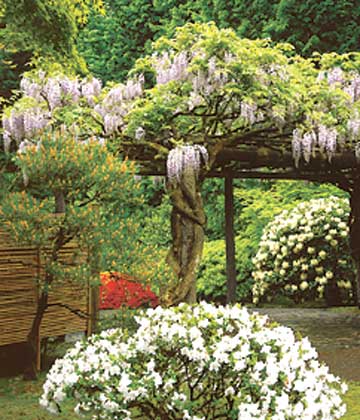 A flowering azalea shrub provides a splash of color.
A flowering azalea shrub provides a splash of color.
Though all shrubs are "clothed" with foliage, not all are simultaneously decorated with flowers. To increase the attractiveness of your garden, include some low-maintenance, flowering shrubs in your design. Three exceptionally low-maintenance native plants that add colorful touches are the plum-leaved azalea (Rhododendron prunifolium), rosebay rhododendron (R. maximum), and oakleaf hydrangea (H. quercifolia). Oakleaf hydrangea, which thrives in sun or shade, provides lovely large flowers and an extra garden bonus -- its handsome foliage turns red in the fall.
Because shrubs come in all sizes, horticulturists often have a hard time distinguishing between a large shrub and a small tree. Before you choose a shrub or a small tree for your border, determine the mature size of the plant, and consider how the plant will fit into the overall garden when it reaches adult size.
Small shrubs, such as dwarf fothergilla (F. gardenii 'Blue Mist'), are perfect for compact garden areas. Large borders, on the other hand, can easily handle -- and often require -- the dramatic presence of a large shrub such as butterfly bush (Buddleia davidii), which produces a magnificent fountain of flowers from midsummer until frost.
Though you may have to wait several years before a newly planted shrub reaches its full size, take its ultimate height into account when planning your border. While it's relatively easy to move flowers, relocating an inappropriately placed shrub is definitely not a low-maintenance task!
Learn how to use bamboo as a border.
Use these vines to shield your landscape.
continue reading below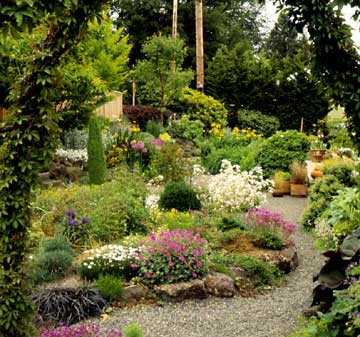 A mixed border creates aninteresting garden arrangement.
A mixed border creates aninteresting garden arrangement.
Mixed borders of shrubs, small trees, and perennials are interesting all year and less work than gardens of herbaceous perennials. The garden pictured contains several azaleas, including the unusual violet blossoms of Rhododendron 'Blue Bird', along with Lawson false cypress (Chamaecyparis lawsoniana) and tall Stewartia (Stewartia monadelpha 'Nana'). Viburnums are durable, easy-care shrubs with clusters of white (or yellowish or greenish) flowers.
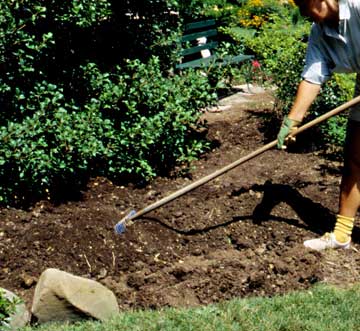 Step 1.
Step 1.
1. Prepare soil. The first step in planting a bed or border of mixed shrubs is to prepare the soil. If you are creating a new garden, first remove the sod. Then loosen the soil and work in 2 inches of compost.
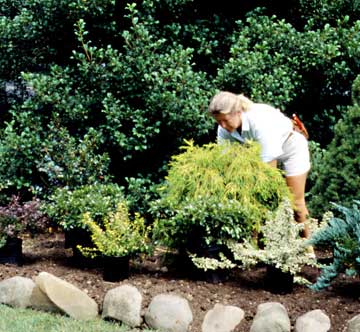 Step 2.
Step 2.
2. Create edging. Edge the bed with boulders, bricks, or fieldstone. Roll -- do not lift -- large rocks into place. This physical barrier will help prevent the lawn grass from spreading into the garden.
 Step 3.
Step 3.
3. Arrange the plants. Before digging any holes, set out the plants in their containers to find the best arrangement and correct spacing. Step back and take a look at your design; then adjust plants as necessary.
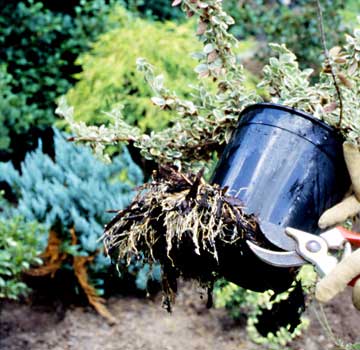 Step 4.
Step 4.
4. Check roots and trim. If plants have been in their containers all summer, trim roots that have grown through the drainage holes. If you buy plants with overgrown roots, check to make sure they are healthy.
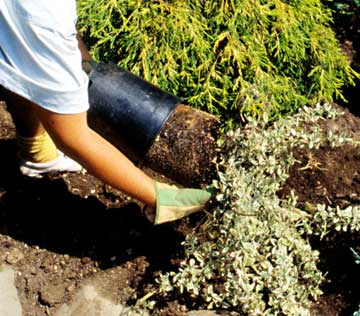 Step 5.
Step 5.
5. Dig holes for plants. Dig a generous-size hole that is wider than the plant's rootball. Loosen the soil in the bottom and sides of the hole, set in the plant, and firm soil around the roots.
6. Place and water all plants. Each shrub should sit at the same depth it was growing in the container. Repeat the planting procedure until all the shrubs are in the ground; then water the plants well.
Copyright © www.100flowers.win Botanic Garden All Rights Reserved